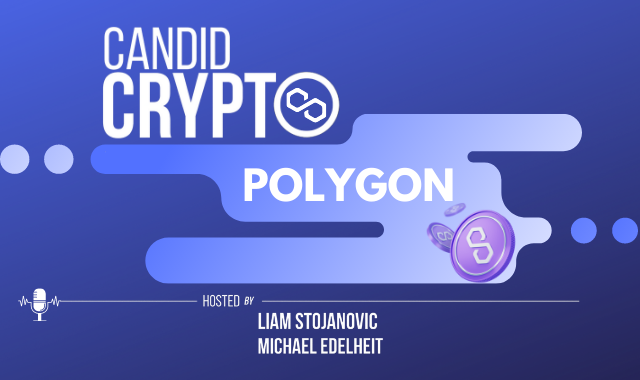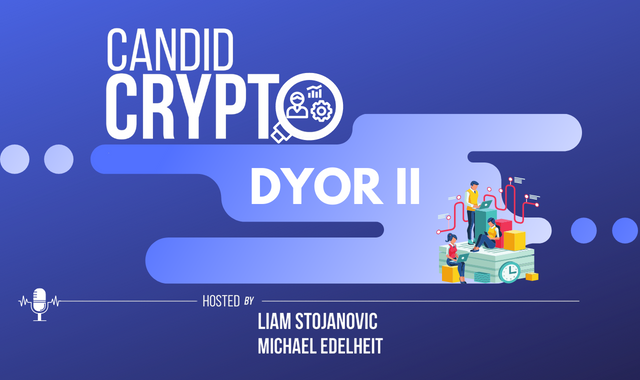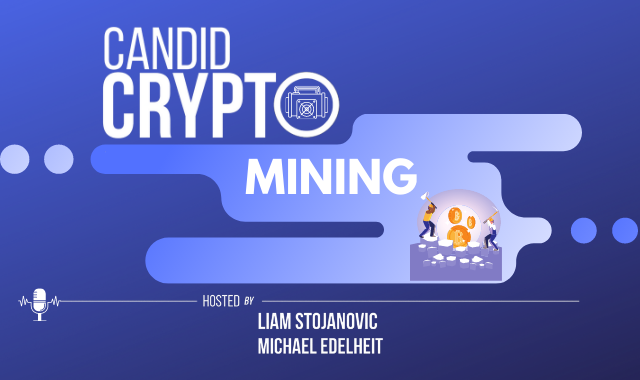019: Polygon
We talk about our favorite shapes. Just kidding. This Polygon promises the Ethereum you know and love at a fraction of the cost.
Please leave a comment and let us know what you think about this episode. You can find Candid Crypto on all your favorite podcast platforms, so please like and subscribe to stay up to date on everything crypto!
In addition, every Candid Crypto episode is transcribed so you can easily understand everything that was discussed.
Episode 19 Transcription – Polygon
Michael 00:00
Polygon, Ethereums Internet of blockchains. That is what the Polygon and Matic token claimed to represent. And today, Liam and I are going to simply break down who created it, its main use cases and why it is significant. And before we get started, I also want to mention that Liam and I recently published a YouTube video of us doing a deep dive on Polygon gathering our research for this episode.
Liam 00:27
We go through the white papers and the light papers, we come up with a few conclusions. You can check it out on YouTube, go to our website CandidCrypto.cc
Welcome to Candid Crypto, a place where anyone can learn about Blockchain Tech.
Michael 00:46
We are two friends who love cryptocurrency and have acted as retail investors and researchers for years. I’m Michael.
Liam 00:55
And I’m Liam.
Our goal is to create a community where listeners can build their knowledge and meet like-minded people in the digital asset space. So Michael, what is Polygon?
Michael 01:10
Polygon is a layer-2 or sidechain scaling solution that runs alongside the Ethereum Blockchain. Essentially, it allows for speedy transactions and low fees. Who doesn’t love that? And what we missed in our YouTube video of the white paper is exactly who created it. So Liam, who created polygon and why?
Liam 01:36
Three individuals from India, Jayant Kanani, Sandeep Nailwal, and Anurag Arjun, so they co-founded Polygon at the time Matic together, which was created in 2017. They also have a 4th core team member listed on the site Mihalio Bjelic. There are 14 members total for the core team of Polygon. And they created it because there’s a big problem with Ethereum. It costs a lot of money and it’s slow.
Michael 02:10
Fun fact Liam. The founders of Matic are also known to be India’s first crypto billionaires. Of course, there could be people that are staying anonymous, that are just sitting on a ton of Bitcoin or whatever crypto they have, but the cofounders of Polygon are public known billionaires.
Liam 02:31
And that was the motivation to really create this sidechain solution, a Blockchain based on another Blockchain, the Ethereum network in this case.
Michael 02:42
Yeah, and it’s definitely significant. And the reason why we’re talking about it is because Matic the native token, has ballooned in valuation. At one point, it was a mere 26 million when it was first issued in 2019. And now it’s around 13, 14 billion. It’s crazy.
Liam 03:01
Yeah. So the goal of Matic is just to be cheaper, and more efficient. The price of it currently sits at $1.65 as of recording this episode on Tuesday, February 1, with a market cap of $12 billion, and a volume of almost a billion dollars in the past 24 hours. There is a total supply of 10 billion Matic and there’s a circulating supply of 07 and a half billion. So two and a half billion of it still has not been minted.
Michael 03:34
It’s also worth knowing that right now, Polygon is still kind of inflationary token where they’re continuing to print new tokens and release them to reward validators. But similar to the Ethereum network, and the implementation of the 1559 protocol, where they burn tokens per transaction, Polygon will be implementing something similar
Liam 03:57
Polygon really went up in value a lot from a year ago, a year ago was 4 cents. Now, it’s $1.65. So that’s a pretty good ROI, if you invested in it a year ago. So maybe thinking, ‘Hey, Liam, how much farther can this thing go?’ And we’ll say at once, but here it is, again, Michael and I are not financial advisors. The upside potential of this could be pretty large. It depends on how motivated people are to flock to layer-2 or scalability solutions like this. A question I’ve always had is, does Ethereum 2.0 negate some of these side chain solutions when it comes out? Is there also an incentive for Ethereum 2.0 to not launch, maybe do two solutions like this? I don’t know where the overlaps are in terms of features and functions. That a theorem 2.0 promises versus Polygon.
Michael 04:55
Those are just some good questions, but I think these layer-2 solutions are still going to be very important just due to the fact that right now on Ethereum, you can really only process 30 transactions per second. And something like Polygon can go upwards of 65,000 transactions per second, which is why it’s less competitive to make these transactions happen. And the fees are significantly less because of that. There’s definitely a lot more, you know, technical magic that’s happening in the background, but it really is significant.
The Polygon team, they really like to think that their technology is a lot more user friendly. And apparently, developers are also seeing this and they’re actually migrating to mainly working with these layer two solutions, because not only does it work on Polygon, it shares very similar characteristics, as Binance and some other very popular side chains. So why build your Dapp directly on Ethereum where you can build it on a side chain like Polygon and also get it onto other platforms as well.
Liam 06:04
That’s Polygon for you.
Thank you so much for tuning in to this week’s episode of candid crypto.
Michael 06:10And if you want to learn more about Polygon, check out our Matic video on YouTube as well. Take a look @polygon.technology to find a lot more resources when it comes to the Polygon Network.







